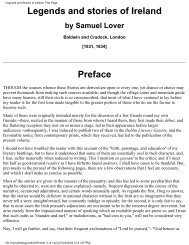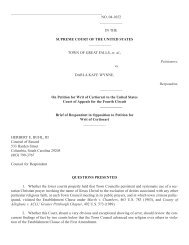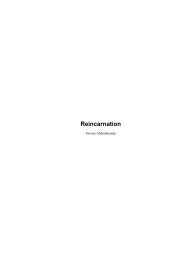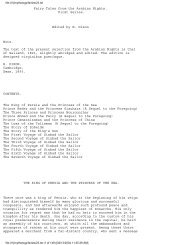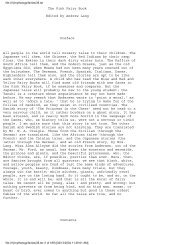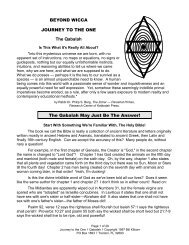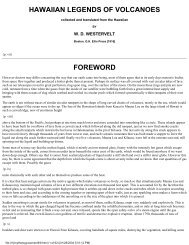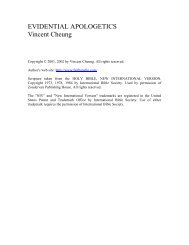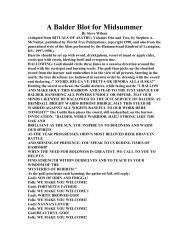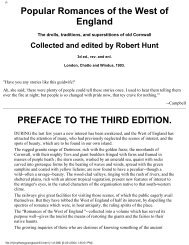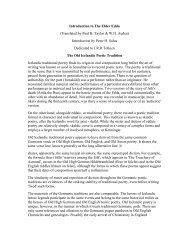You also want an ePaper? Increase the reach of your titles
YUMPU automatically turns print PDFs into web optimized ePapers that Google loves.
side only could be seen. Here again it was found that thieves had already been at work, and that they had<br />
smashed in pieces walls, floors, and many other parts of the chambers in their frantic search for treasure.<br />
As in the case of the pyramid of Unas, certain chambers, etc., of this tomb were found covered with<br />
inscriptions in hieroglyphics, but of a smaller size.[3] A brief examination of the text showed it to be<br />
formed of a series of extracts from the Book of the Dead, some of which were identical with those in the<br />
pyramid of Unas. Thus was brought to light a Book of the Dead of the time of the first king 4 of the VIth<br />
dynasty.<br />
and of the pyramid of Pepi I., Mer-en-Ra, and Pepi II.<br />
The pyramid of Pepi I., king of Egypt about B.C. 3233, was next opened.[5] It is situated in the central<br />
group at Sakkâra, and is commonly known as the pyramid of Shêkh Abu-Mansûr.[6] Certain chambers<br />
and other parts of the tomb were found to be covered with hieroglyphic texts, which not only repeated in<br />
part those which had been found in the pyramids of Unas and Teta, but also contained a considerable<br />
number of additional sections of the Book of the Dead.[7] In the same neighbourhood M. Maspero,<br />
cleared out the pyramid of Mer-en-Ra, the fourth king of the VIth dynasty, about B.C. 3200;[8] and the<br />
pyramid of Pepi II., the fifth king of the VIth dynasty, about B.C. 3166.[9]<br />
[1. The mummy of the king had been taken out of the sarcophagus through a hole which the thieves had made in it; it was<br />
broken by them in pieces, and the only remains of it found by M. Maspero consisted of an arm and shoulder. Parts of the<br />
wooden coffin are preserved in the Gizeh Museum.<br />
2. The Pyramids of Gizeh, vol. iii., p. 39.<br />
3. They were copied in 1882, and published by M. Maspero in Recueil de Travaux, t. v., pp. 1-59.<br />
4. The broken mummy of this king, together with fragments of its bandages, was found lying on the floor.<br />
5. See Vyse, Pyramids of Gizeh, vol. iii., p. 5<br />
6. It had been partially opened by Mariette in May, 1880, but the clearance of sand was not effected until early in 1881.<br />
7. The full text is given by Maspero in Recueil de Travaux, t. v., pp. 157-58, Paris, 1884; t. vii., pp. 145-76, Paris, 1886;<br />
and t. viii., pp. 87-120, Paris, 1886.<br />
8. It was opened early in January, 1880, by Mariette, who seeing that the sarcophagus chamber was inscribed, abandoned<br />
his theory that pyramids never contained inscriptions, or that if they did they were not royal tombs. The hieroglyphic texts<br />
were published by Maspero in Recueil de Travaux, t. ix., pp. 177-91, Paris, 1887; t. X, pp. 1-29, Paris, 1388; and t. xi., pp.<br />
1-31, Paris, 1889. The alabaster vase in the British Museum, NQ 4493, came from this pyramid.<br />
9. This pyramid is a little larger than the others of the period, and is built in steps of small stones; it is commonly called by<br />
the Arabs Haram el Mastabat, because it is near the building usually called Mastabat el-Far'ûn. See Vyse, Pyramids, vol.<br />
iii., p. 52. The hieroglyphic texts are published by Maspero in Recueil de Travaux, t. xii., pp. 53-95, and pp. 136-95, Paris,<br />
1892; and t. xiv., pp. 125-52, Paris, 1892. There is little doubt that this pyramid was broken into more than once in<br />
Christian times, and that the early collectors of Egyptian antiquities obtained the beautiful alabaster vases inscribed with<br />
the cartouches and titles of Pepi II. from those who had access to the sarcophagus chamber. Among such objects in the<br />
British Museum collection, Nos. 4492, 22,559, 22,758 and 22,817 are fine examples.]<br />
{p. xxiv}<br />
Summary of the monumental evidence.<br />
Thus we have before the close of the VIth dynasty five copies of a series of texts which formed the Book<br />
of the Dead of that period, and an extract from a well-known passage of that work on the wooden coffin<br />
file:///I|/mythology/egypt/1/1.html (14 of 189) [01/25/2004 3:29:57 PM]



